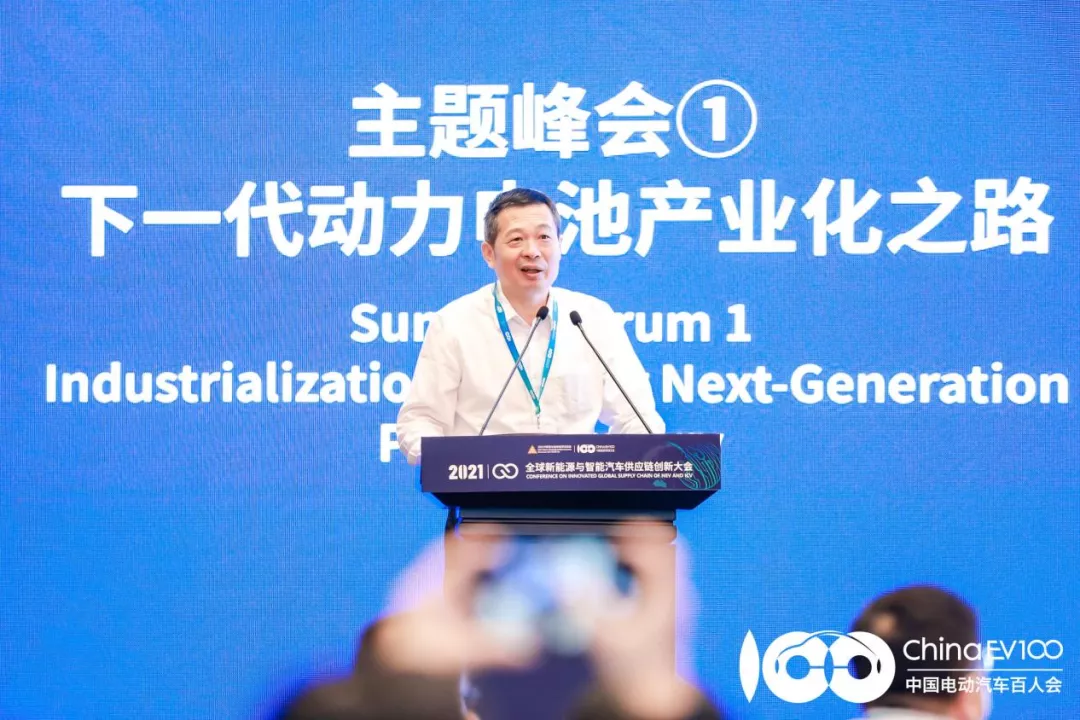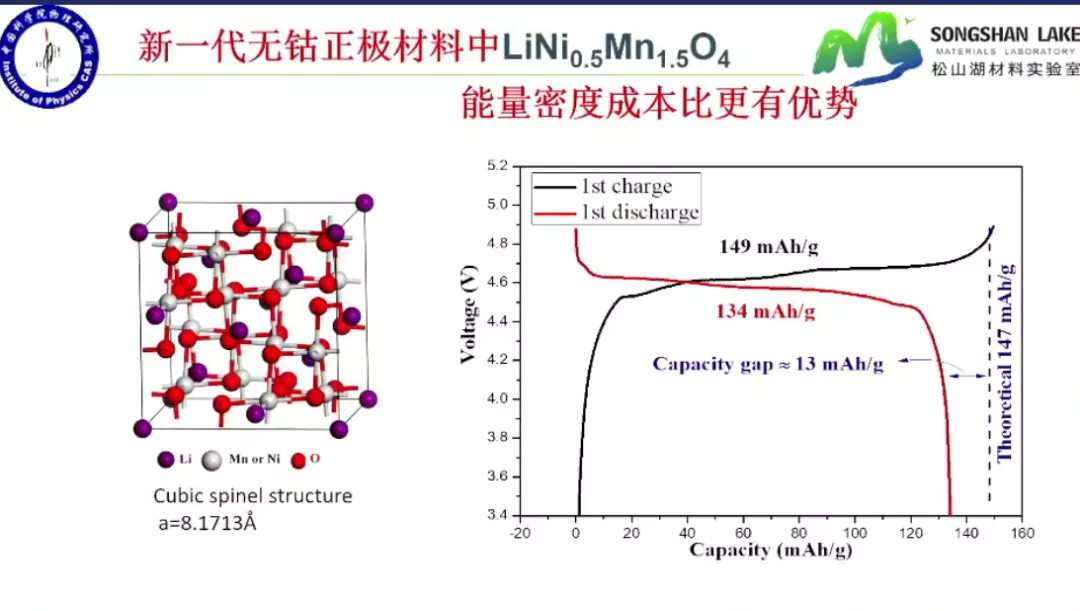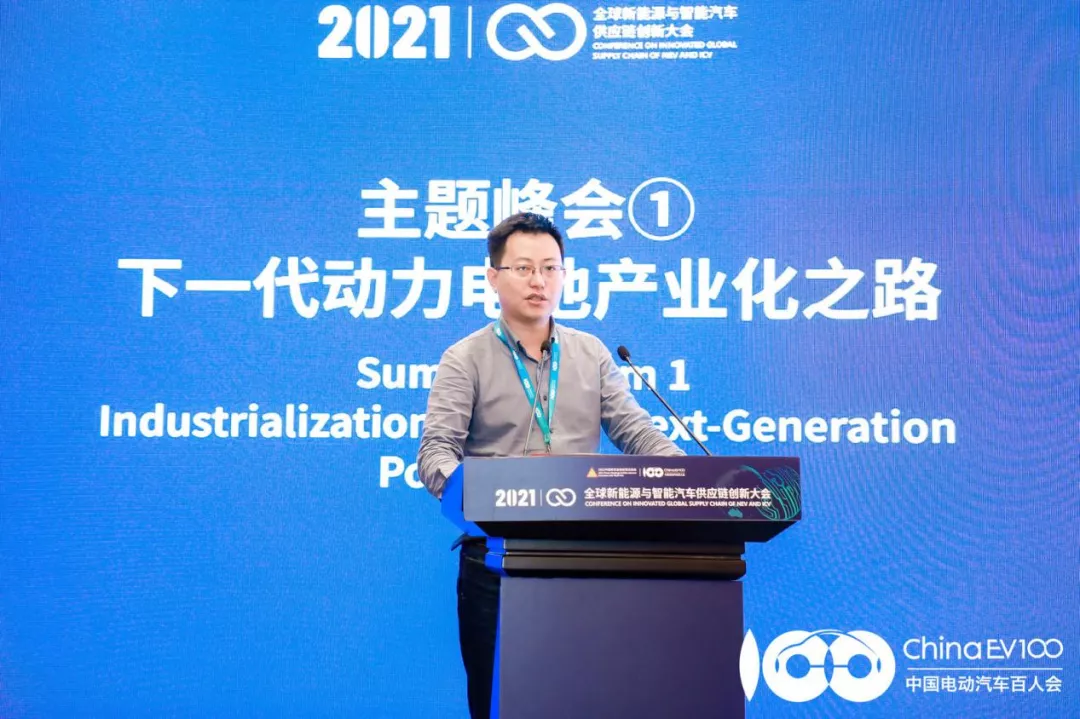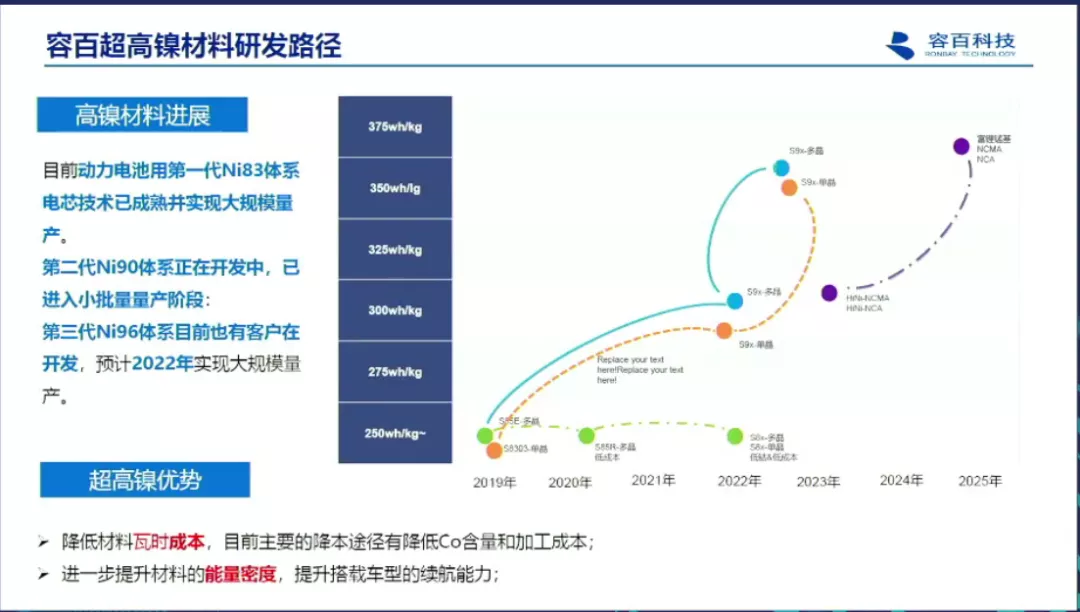Author: Wang Lingfang
Power battery is the biggest bottleneck that needs to be overcome for the development of new energy vehicles.
New energy vehicles need to have long driving range, fast charging speed, good low-temperature performance, and low prices, all of which require the progress of power battery technology to solve.
Nowadays, with the continuous rise of upstream raw materials and the addition of “dual carbon” requirements, new challenges have been put forward for power batteries.
On October 11-12, 2021, the 3rd Global New Energy and Intelligent Automobile Supply Chain Innovation Conference was held in Nanjing. On October 12, on the “Road to Industrialization of Next-Generation Power Batteries”, industry experts and representatives of battery companies conducted in-depth analysis of the development trend of battery technology, and unanimously regarded low-cobalt and solid-state batteries as the key directions for the next step of development.
Among them, low-cobaltization is divided into two routes: high-nickel and low-nickel; some enterprises also elaborated on the negative pole and auxiliary material technology of batteries, as well as the development direction of recovery technology.
Major direction: reducing cobalt content in positive electrode
In the opinion of Huang Xuejie, Vice-chairman of China Battery Industry Association: the lithium manganate technology used by Nissan Leaf in 2010 was the first generation of power battery technology, and now the battery technology is in the second generation, with the mainstream being lithium iron phosphate and ternary batteries, with a range more than doubled compared to the first generation.
Huang Xuejie said that the safety of iron lithium is higher and the cost is lower, but the range is not long enough; the range of ternary is long enough, but it is still more expensive and needs to be safer, so it is necessary to move forward.
Therefore, Huang Xuejie believes that reducing cobalt in ternary batteries is the trend. Reducing nickel and increasing nickel are also different routes. One way to reduce nickel is to turn ternary into binary nickel-manganese lithium; there is also a way to increase nickel, which is to make high-nickel batteries to increase energy density.

(1) Route One: Reducing nickel content
Huang Xuejie believes that for reducing nickel, the key material is nickel-manganese lithium. The first-generation material is lithium manganate, which has the same spinel structure. After replacing 1/4 of manganese with nickel, the negative electrode is matched with graphite. The voltage can be above 4.5V. “The standard voltage of lithium iron phosphate battery is 3.2V, and the standard voltage of ternary battery is 3.6V. If it can be increased to 4.5V, the energy density will have an advantage.”

Although nickel-manganese lithium may have a chance to achieve higher range, higher cost-effectiveness, and higher safety, it is difficult to guarantee its lifespan after the voltage is increased.黄学杰团队 utilized a special interface layer structure design and functional adjustment of the electrolyte to significantly improve the stability of the nickel-manganese-cobalt lithium-ion battery. Additionally, there were no changes in the workmanship, cost, negative electrode matching, electrolyte, separator, and shell of the battery.
In terms of product performance, the energy density of the nickel-manganese-cobalt lithium-ion battery developed by Huang’s team is increased by about 40% compared to lithium iron phosphate, with a cost reduction of more than 20%. Compared to the ternary battery, the cost is reduced by about 40%, and the safety is higher.
China Aviation Lithium Battery also sees the spinel nickel-manganese-cobalt lithium-ion as the next generation of positive electrode candidate materials.
Xie Qiu, the general manager of China Aviation Lithium Battery’s passenger car business, stated that they have made a calculation. Currently, in the normal NCM 5 and 6 series materials, only 70% of lithium is utilized, and the other 30% of lithium does not participate in charging and discharging, causing enormous waste of resources. “The lithium participating in the reaction of spinel nickel-manganese-cobalt lithium-ion can reach 95%, which is similar to the lithium utilization rate of lithium iron, but the energy density of nickel-manganese-cobalt lithium-ion with spinel structure is much higher,” Xie Qiu said.
Xie Qiu believes that if the utilization rate of lithium can be increased from 70% to 95%, it means that our demand for lithium can be reduced by about 30%. From the perspective of cost and resources, low-nickel and high-manganese spinel nickel-manganese-cobalt lithium-ion is the candidate solution for the next generation of battery materials.
The second cobalt-reduction route mentioned by Huang Xuejie was the increase of nickel content. To increase the capacity, the capacity of nickel can be increased. The energy of the positive electrode material can be increased from 160mAh/g to 180mAh/g, and further increased to 200mAh/g.
One major weakness of high-nickel batteries is relatively poor life span and stability. In order to overcome this shortcoming, the industry is researching gradient materials with the support of national key R&D projects. For example, by completely removing cobalt, nickel-cobalt lithium-ion batteries can be produced through internal doping and external gradient.黄学杰 stated that if the nickel-cobalt-aluminum (NCA) batteries move towards nickel-manganese-cobalt (NMC) or ternary materials, the energy density may increase by approximately 40%. Combining with negative electrode alloying materials, the energy density may be increased from less than 700Wh/L to 1000Wh/L. “Whether it is lithium iron phosphate or ternary, we have seen a 40% increase in energy density and the possibility of cost improvement, and these will be manifested in nickel-manganese-cobalt.”
In the field of high-nickel electrodes, CECU Technology is a leading enterprise. She Shengxian, assistant to the president of Ningbo CECU New Energy Technology Co., Ltd., is optimistic about the development prospects of high-nickel materials.

She Shengxian provided a set of data. From January to August of this year, the global overall battery growth rate increased rapidly, and two relatively subdivided markets are worth paying attention to. Lithium iron phosphate increased by 160%, and the growth rate of 811 in the ternary materials field is even higher, reaching more than 250%.
She Shengxian believes that in the future, electric vehicles will not only be a means of transportation but also a carrier for work and entertainment, and require the realization of autonomous driving. These requirements have high demands on power consumption, and at least a 30% increase from the current level is required for the features of autonomous driving. When the temperature is above 115 degrees, a standard battery demand is required. If lithium iron phosphate is used, the entire vehicle may be 400 kilograms heavier than the high-nickel ternary batteries, which will cause significant problems.
In She Shengxian’s view, the cost of high-nickel materials will decrease rapidly in the next few years. The approximate node is that in 2025, the watt-hour cost of high-nickel ternary PACK will be close to that of lithium iron phosphate, and it will be basically consistent by 2030.
She Shengxian stated that achieving this rapid cost reduction is achieved from different levels. Firstly, the development of overseas raw material bases like nickel will reduce metal costs. In addition, as the large-scale production of high-nickel batteries reduces the cost of battery modules such as CTP and C2C, high-nickel ternary will also be used for battery module technology. In the future, most of the positive electrode materials in solid-state batteries will use high-nickel manganese-cobalt 811 and NCA.
CECU has successfully and widely applied the first-generation Ni83 system battery technology, and the second-generation Ni90 system is under development and has entered the small-scale stage. The third-generation Ni96 system is under development with clients, and is expected to achieve mass production in 2022.

中航锂电 is also developing 9-series ultra-high nickel materials and key technologies such as pre-lithiation and nano-silicon. According to Xie Qiu, the finished product produced by CATL can be pierced 2mm deep by a 1mm steel needle according to the standard of shallow puncture, and the battery pack performance will show a voltage drop in the test.
Of course, using high nickel positive electrode materials can further enhance the energy density of the battery, contributing to vehicle lightweighting, which can indirectly achieve the goal of reducing carbon emissions.
Negative electrode, auxiliary materials, and structural innovation
Before the mass production of solid-state batteries is achieved, experts and enterprises in the industry are constantly exploring the potential of liquid-state batteries.
Therefore, in addition to the positive electrode, the negative electrode also needs to be continuously improved and upgraded.
Xie Qiu believes that, first of all, the negative electrode material needs to reduce resource consumption, considering the application of natural graphite. Natural graphite is less commonly used in domestic power batteries, and the graphitization process is also a high-energy consumption process. Natural graphite is also the focus of research in the next step. Second is to improve performance, such as how to continuously improve energy density, improve fast charging speed, including the modification of the coating of these natural graphite and the application of silicon materials, which are the research work to be done for the negative electrode in the next step.
Xie Qiu also mentioned structural innovation. CATL has achieved the goal of simplifying the battery pack structure through structural innovation. By reducing the weight of structural components, the weight and space can be maximized for active substances. Xie Qiu explained that the weight of structure components per liter of their first-generation product was 400g, while the product to be launched next year will be reduced to 120g/L.
In addition, the DCR (DC resistance) in the battery is also continuously reduced, and the DCR of the structure components is designed to be as minimal as possible, from 0.2 to 0.15 milliohm, and assembly processes are being simplified.
CATL’s structural simplification is also reflected in the battery cells. Xie Qiu stated that its One-Stop battery, which has been released, is the fourth type of packaging form after soft pouches, cylindrical, and square shapes, and has made many innovations in the entire process equipment.Xie Qiu introduced that One-Stop can increase energy density by about 10% while reducing 20% of components on the premise of an unchanged system. Within the same space, it can change from ternary to iron-lithium, because the volume energy density is higher. Iron-lithium can support 700 km, and the energy density of the battery pack can reach 160 Wh/kg. If it uses ternary, the range can support 1000 km, and the energy density of the battery pack will reach 240 GWh/kg.
Xie Qiu stated that their products can be announced in the fourth quarter of this year. The energy density of the battery pack can reach 220 Wh/kg, and mass production will start next year.
Solid-state Battery Exploration
The biggest problem of solid-state batteries is the interface conductivity.
Li Hong, a researcher at the Institute of Physics, Chinese Academy of Sciences, explained that the difficulty of solid-state batteries is how the solid-state electrolyte can maintain good contact with the positive and negative electrode particles during the expansion process, preferably at the atomic level.
To this end, Li Hong has two plans: one is to grow solid-state electrolyte on the surface of positive and negative electrode particles, and the other is to transform liquid or slurry electrolyte into a solid state during battery formation or electrode manufacturing.
Li Hong explained that the measures their team is taking now are to use silicon negative electrodes or lithium-carbon composite negative electrodes, plus solid-state electrolytes, plus SEI films, with the positive electrodes covered with solid-state electrolytes and solid-state electrolyte powder, as well as in situ polymerized solid-state electrolyte solution. The middle membrane is a basic film of PE and PP, coated with solid-state electrolyte on both sides.
Li Hong explained that they chose LATP (Li1.5Al0.5Ti1.5 (PO) 4) mainly because the activity of LATP on the negative electrode side can induce the SEI film to grow on the negative electrode side, thereby forming a continuous ion channel from the negative electrode to the positive electrode, which is a crucial point.
In addition, LATP can react with metallic lithium and prevent the deposition of lithium dendrites. Overall, this plan can achieve the production of large-capacity battery packs while improving safety and energy density.
On the positive electrode side, currently some companies are developing towards Ni95 and Ni98, with a capacity even aiming at 230mAh/g.In terms of the negative electrode, Li Hong believes that silicon anode has promising prospects. Li Hong stated that there are various types of silicon anodes currently being developed, including nano-silicon-carbon, which is now in mass production as well.
In Li Hong’s opinion, there are still significant challenges in using nano-silicon-carbon as a power battery, such as controlling its expansion and cycle performance. Nevertheless, with the new generation solution of nano-silicon technology, it has the potential to replace silicon dioxide again in the future. Although the cycle performance and specific capacity of SiO2 coated with carbon can meet the requirements for industrialization, there are still significant challenges in developing pre-lithiation or pre-magnesiation at the material level or electrode-level prelithiation for engineering purposes.
Besides, micron-scale silicon also deserves attention. If there is no interface reaction, micron-scale silicon can also become an important negative electrode material for solid-state batteries.
According to Li Hong, the improvement of auxiliary materials is also essential. They have gradually started to use single-wall carbon nanotubes to reduce the amount of carbon black used in silicon anodes, thus ensuring electronic contact during the cycling process. They are also attempting to replace separators with solid-state electrolyte-coated separators. Additionally, current collectors might be transformed into MPCCs (Metalized Plastic Current Collectors), which improve the strength of current collectors and reduce their weight.
Li Hong revealed that several solid-state battery companies in China may enter mass production by the end of next year, with a production target of about GWh.
Battery Recycling: Shorten the Recycling Process
Regarding recycling, Xie Qiu believes that batteries should ideally fulfill their full value during their period of service in vehicles and begin recycling after retirement.
Xie Qiu believes that the current recycling technology is considered to be third-generation technology. The first generation is brute force burning; the second generation is crushing and throwing the batteries in. The third generation aims to achieve refined and automated dismantling. CATL hopes to separate copper foils, aluminum foils, positive electrodes, and negative electrode materials entirely for increased efficiency and then undergo short-cycle in-situ regeneration.
The industry’s general practice is to crush batteries into salt, cobalt sulfate, and nickel sulfate before recycling them into materials. CATL hopes to reduce the process and directly perform relevant regeneration at the material level to reduce overall carbon emissions and costs.
Currently, in terms of reducing cobalt usage, it has become a consensus to reduce the nickel content of spinel lithium manganese oxide. High-nickel ternary batteries are also gradually heating up, and liquid batteries still have some development space through improvements in negative electrodes, structures, and other aspects. A batch of lithium-ion batteries with higher nickel content and innovative structures will be pushed to the market next year.In the field of solid-state batteries, solid-liquid hybrid state batteries will also gradually emerge next year, and a batch of semi-solid-state battery production capacity will also begin construction. The overall power battery technology will continue to advance in a “small step, fast run” state.
This article is a translation by ChatGPT of a Chinese report from 42HOW. If you have any questions about it, please email bd@42how.com.